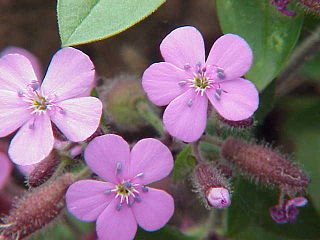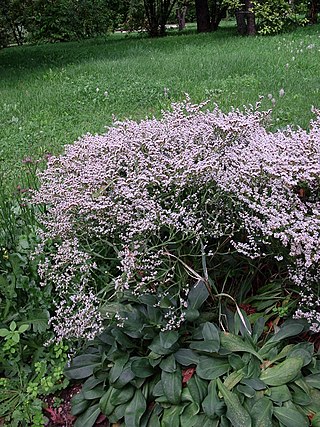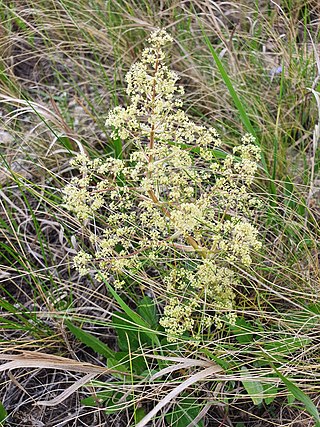
Lolium is a genus of tufted grasses in the bluegrass subfamily (Pooideae). It is often called ryegrass, but this term is sometimes used to refer to grasses in other genera.

Saponaria is a genus of flowering plants in the family Caryophyllaceae, native to Asia and Europe, and are commonly known as soapworts. They are herbaceous perennials and annuals, some with woody bases. The flowers are abundant, five-petalled and usually in shades of pink or white. The genus is closely related to the genus Silene, being distinguished from these by having only two styles in the flower. It is also related to Gypsophila, but its calyx is cylindrical rather than bell-shaped.

Colutea is a genus of about 28 species of deciduous flowering shrubs in the legume family Fabaceae, growing from 2–5 m tall, native to southern Europe, north Africa and southwest Asia. The leaves are pinnate and light green to glaucous grey-green. The flowers are yellow to orange, pea-shaped and produced in racemes throughout the summer. These are followed by the attractive inflated seed pods which change from pale green to red or copper in colour.

Anthemis is a genus of aromatic flowering plants in the family Asteraceae, closely related to Chamaemelum, and like that genus, known by the common name chamomile; some species are also called dog-fennel or mayweed. Anthemis are native to the Mediterranean region and southwest Asia east to Iran. A number of species have also become naturalized in the United Kingdom and other parts of the world.

Fagonia is a genus of wild, flowering plants in the caltrop family, Zygophyllaceae, having about 34 species. The latest reorganization of the genus took place in 2018 when systematists Christenhusz & Byng, Royal Botanical Gardens, Kew (UK) included Fagonia spp.. along with several other Zygophyllum genera, into a new genus named "Zygophyllum L." Species occurring in the US are commonly referred to as fagonbushes. The distribution of the genus includes parts of Africa, the Mediterranean Basin, the Mid-East, India, and parts of North & South America. Fagonia species have been used ethnobotanically by traditional practitioners under Ayurvedic and other TM healing regimes for many maladies. Species occur in deserts, dry washes, ditches and on rocky outcrops, including at altitude.

Aethionema is a genus of flowering plants within the family Brassicaceae. They are known as stonecresses. Stonecresses originate from sunny limestone mountainsides in Europe and West Asia, especially Turkey.

Scilla luciliae is a species of flowering plant in the family Asparagaceae. It is referred to by the common names Bossier's glory-of-the-snow or Lucile's glory-of-the-snow, and is a bulbous perennial from western Turkey that flowers in early spring. After flowering, it goes into dormancy until the next spring. The specific epithet is in honour of Lucile, the wife of the Swiss botanist Pierre Edmond Boissier (1810-1885). It belongs to a group of Scilla species that were formerly put in a separate genus, Chionodoxa, and may now be treated as Scilla sect. Chionodoxa.

Betonica is a genus of the plants in the family Lamiaceae.
Lactuca orientalis is a Eurasian species of plant in the tribe Cichorieae within the family Asteraceae. It is widespread across the Middle East and southern Asia as far east as Tibet.

Wulfenia is a plant genus in the family Plantaginaceae. The genus was named after Franz Xaver von Wulfen (1728–1805), an Austrian botanist, zoologist, mineralogist, alpinist, and Jesuit priest. It was first described in 1781 by Nikolaus Joseph von Jacquin in. It is also in Tribe Veroniceae.

Allium libani is a species of wild bulbous plant geophyte of the genus Allium, belonging to the family of Amaryllidaceae. Allium libani is endemic to the Middle East in Lebanon and Syria.

Ungernia is a genus of bulb-forming plants in the Amaryllis family, native to central and south-central Asia Asia.
Ferula hermonis is a species of flowering plant in the Apiaceae family. It is native to Lebanon, Syria and Turkey. The epithet hermonis refers to Mount Hermon on the border between Syria and Lebanon.

Prangos is a genus of flowering plants of the family Apiaceae, native from Europe to Mongolia and the western Himalayas.

Goniolimon, sometimes called the statices, are a genus of flowering plants in the leadwort and plumbago family Plumbaginaceae, native to northern Africa, southern Europe, western and central Asia, Siberia, Mongolia and China. Low-lying perennial shrubs, some species are cultivated as ground covers.
Digitalis cariensis is a species of flowering plant in family Plantaginaceae. It is a type of foxglove. It is native to southwestern to southern Turkey.
Semenovia is a genus of flowering plants belonging to the family Apiaceae. It is in subfamily Apioideae and also tribe Tordylieae subtribe Tordyliinae.
Petiniotia is a monotypic genus of flowering plants belonging to the family Brassicaceae. It only contains one known species, Petiniotia purpurascens(Boiss.) J.Léonard
Petroedmondia is a monotypic genus of flowering plants belonging to the family Apiaceae. It only contains one known species, Petroedmondia syriaca.

Trinia is a genus of flowering plants in the family Apiaceae, native from Europe to Iran and western Siberia. The genus was first described by Georg Franz Hoffmann in 1814.














